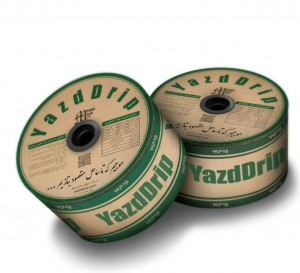Drip irrigation tape
One of the pressurized irrigation methods that has been developed in recent years is the drip irrigation method using a drip irrigation tape. These tapes have water outlet holes along their length and at regular intervals, and they release water in the form of drops with specific pressure and flow rate. Drip tape can be installed on the surface and depth of the soil, and due to its raw materials, it is resistant to sunlight, chemical compounds, herbicides, and other acid compounds, and is used for watering gardens, crops, planting rows, and greenhouses, such as tomatoes, potatoes, onions, strawberries, cucumbers, corn, wheat, sugar beets, etc.
By complying with international standards and obtaining the necessary approvals, Yazd Drip tape is an efficient and essential product in the Hinovin irrigation system and can compete with foreign samples in the market, it can make a significant contribution to reducing water consumption, reducing irrigation costs, and increasing bring the productivity of land and human power.
Technical specifications of YazdDrip irrigation tape
Thickness: 175 microns (can be changed according to the customer’s order)
Pipe diameter: 16 mm
The distance of the droppers: 10cm, 20cm and 30cm
Watering rate: 2.5 to 3 liters per hour
Length of each roll: 1000 meters (can be changed according to customer’s order)
Distinctive features of YazdDrip Irrigation Tape
High resistance to sunlight due to the use of anti-UV additives
Resistance to crushing, scratching and tearing due to the use of a unique combination of light, heavy and linear polymers.
Uniform watering and minimal clogging of nozzles due to proper design
Guaranteed for one crop season
Certified by the Water and Soil Department of Jahad Agriculture
Very reasonable price compared to foreign samples with similar quality
Advantages of using YazdDrip irrigation tape
Save water consumption up to 93%
Preventing soil erosion, because of the fact that traditional irrigation causes erosion and as a result, increases the amount of salt in the soil
Optimal use of land due to no need to create earthen streams
Easy installation and assembly
Elimination of weed problems and the cost of removing it
Uniform and more favorable growth of the plant
Increase production up to 90%
Distribution of water and fertilizer in the right amount and time
Increasing fertilization efficiency
